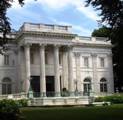
Beaux Arts (1885s – 1925s)
Combining classical Greek and Roman architecture with Renaissance ideas, Beaux Arts was a favored style for grand public buildings and opulent mansions.
History:
The Beaux Arts (French for “fine art”) style originated in the École des Beaux Arts in Paris. Many American architects studied at this legendary architectural school, where they learned about the aesthetic principles of classical design and brought them to the United States.
Also known as Beaux Arts Classicism, Academic Classicism, or Classical Revival, Beaux Arts is a late and eclectic form of Neoclassicism. It combines classical architecture from ancient Greece and Rome with Renaissance ideas. Beaux Arts is characterized by order, symmetry, formal design, grandiosity, and elaborate ornamentation. In the United States, the Beaux Arts style led to planned neighborhoods with large, showy houses, wide boulevards, and vast parks. Due to the size and grandiosity of the buildings, the Beaux Arts style is most commonly used for public buildings like museums, libraries, banks, courthouses, and government buildings.
The popularity of the Beaux Arts style waned in the 1920’s, and within 25 years the buildings were considered ostentatious. Later in the 20th century, postmodernists rediscovered an appreciation of the Beaux Arts ideals.
Features:
Massive and grandiose – Constructed with stone
Balustrades
Balconies
Columns
Cornices
Pilasters
Triangular pediments
Lavish decorations: swags, medallions, flowers, and shields
Grand stairway
Large arches
Symmetrical façade
Next: Tudor Revival